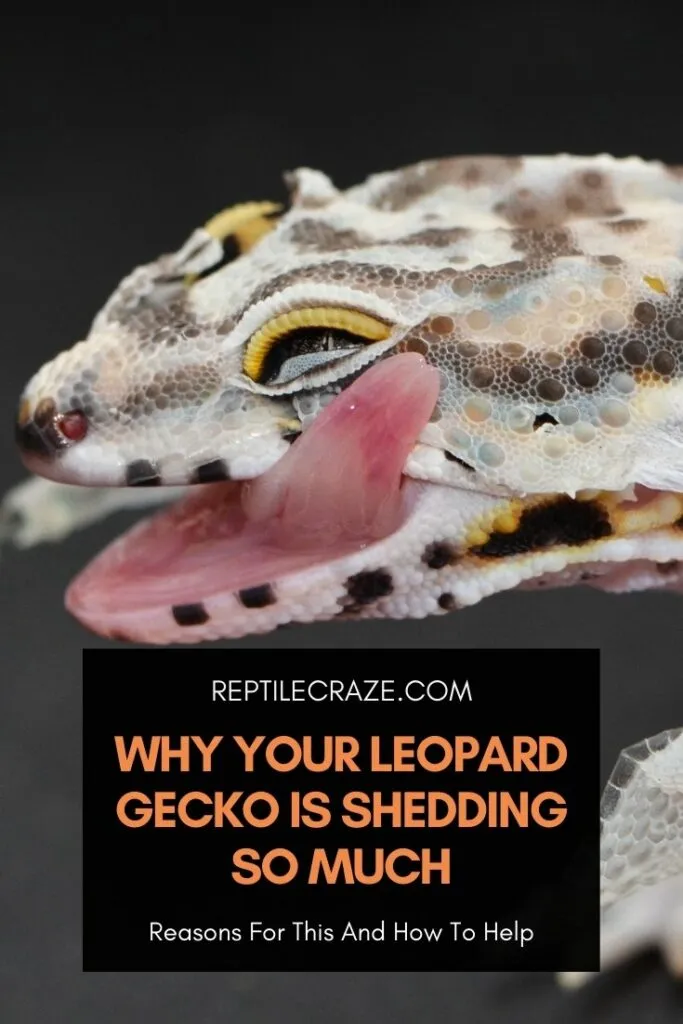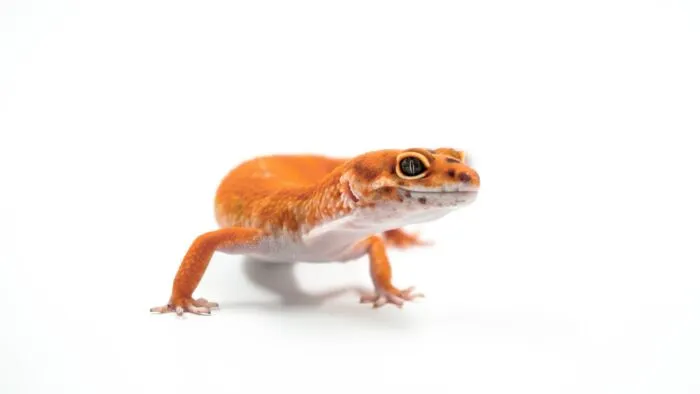
When I first started out as a leopard gecko owner, I knew that they shed their skin every now and then. However, when my female leopard gecko, Molly, started to shed her skin far more often, I wondered if it was too much. Was there something wrong?
Leopard geckos need to shed their skin to stay healthy. Young leopard geckos shed every 1 – 2 weeks, while adult leopard geckos shed every 4 – 8 weeks. If your leopard gecko is shedding more often than this, it is usually because its body is stressed by disease, mites, or poor nutrition.
To figure out what’s causing your leopard gecko to shed so much, and how to help your little lizard buddy, I’ve put together a handy guide below.
Table of Contents
What Causes Excess Shedding in Leopard Geckos?
If your leopard gecko is shedding far more often than is healthy, then it’s usually indicative of an underlying problem. Sometimes, it looks like your pet is shedding too much, but the problem is actually retained skin that’s become more noticeable.
The medical term for abnormal shedding is called dysecdysis, and it’s helpful to think of it as a symptom of another issue.
If you solve the underlying reason for abnormal skin shedding, then the skin shedding will begin to happen at a healthy rate.
Let’s look at some of the most common causes of excess skin shedding in leopard geckos, so we can help your lizard buddy get back on its feet.
Note: If your leopard gecko is shedding excessively and appears to be sick, bring it to a vet asap. If you don’t live near an exotic vet, book an online vet here!
1. Parasites
Several parasites can cause problem skin shedding. Most of these are intestinal, such as cryptosporidium. These parasites feed on nutrients inside of the leopard gecko’s body causing weight loss and lack of appetite. Malnutrition can then cause significant skin problems and even death.
2. Mites
Also known as ectoparasites, these are little blood-sucking arachnids. That’s right, spider Draculas! All you need is some garlic and a wooden stake… Okay, but seriously, these pests are usually as small as a speck of pepper and red in color.
As they feed, they can cause severe skin irritation in some leopard geckos, but they also carry diseases that can make your pet ill in other ways.
3. Dehydration
Probably the most common cause of excess skin shedding is dehydration. When a leopard gecko doesn’t get enough water, its skin can dry out, sag, and begin to peel.
This creates dryer skin that makes shedding more difficult. As a result, patches of skin may come off over a longer period of time or, in some cases, the skin will stick to the layer beneath.

4. Thermal Burns
If your leopard gecko can reach up and touch its heat lamp, or the environment is too hot, its skin can burn. Any burns can result in excess shedding as they heal.
5. Low Humidity
If the humidity of your
6. No Hide Area
Leopard Geckos need places to hide, especially during the warmest parts of the day. They tend to enjoy low light or dark areas. But they also need hiding spaces that will retain moisture.
Caves or boxes lined with a moist substrate like sphagnum can provide this. This will help to keep your leopard gecko’s skin hydrated and healthy.
7. Stress
As much as we all love our leopard geckos, they can be easily affected by stressful situations. Being handled too often and competing with more aggressive geckos can cause anxiety that can stop them from eating or make them lethargic and skittish. This can eventually lead to abnormal skin shedding.
8. Malnutrition
If your leopard gecko isn’t getting the right foods, abnormal skin shedding can become a problem. That’s why it’s so important that you provide the right leopard gecko diet.
How Bad is Abnormal skin shedding?
In leopard geckos, abnormal skin shedding can lead to:
- Open wounds on the skin that can become infected
- Difficulty breeding
- Loss of digits due to constrained blood flow
- Amputation of digits or limbs
- Underlying skin drying out
How to Spot Skin Shedding Problems
It’s difficult at first to know the difference between healthy and unhealthy skin shedding. Thankfully, there are ways to assess this.
Take pictures of your gecko (without a flash) every two days. Compare the differences. If the skin looks ready to be shed but remains there for more than a week, then you know skin retention is the problem.
Likewise, if you notice the same spots of skin shedding more regularly than every three or four weeks, then excess skin shedding is the culprit.
There are also some sensitive areas you should keep an eye on for shedding problems. They can often be an early indicator of oncoming abnormal shedding.
Eyelid Shedding
Unlike many other lizard species, leopard geckos have eyelids. This is in place of a transparent scale called the brille (sometimes known as an ocular scale, eye cap, or spectacle) that permanently covers the eye of most reptiles for protection.
Because of these eyelids, your leopard gecko won’t shed skin from the eyes. Instead, you’ll see it happening both on and around the eyelids.
Tail Shedding
The skin around the tail should shed as normal, but look out for patches of retained skin especially around the tip of the tail.
Toe Shedding
This is the most common place to find shedding problems on a leopard gecko. Due to their toes being so small, sometimes skin can wrinkle up and stick to them. When this happens, it’s especially important to take action, as shedding problems on the toes can sometimes result in amputation.
Vent Shedding
On the underside of your leopard gecko where the tail begins, you can find your pet’s “vent”. It’s where your lizard defecates. Skin shedding problems can happen around the vent, and you might notice your leopard gecko licking its vent to try to soothe the problem.

How to Treat Excess Skin Shedding in Leopard Geckos
There are two things you’ll need to do to treat this problem:
- Help your leopard gecko shed its skin properly
- Treat the underlying cause of the abnormal shedding
Treating Excess Skin Shedding
To help your leopard gecko shed normally, you’ll want to get rid of the skin it is retaining for too long, while hydrating the other layers of healthy skin to return them to a healthy shedding schedule.
To achieve this, you have to remove dead skin that has become stuck to your leopard gecko. This needs to be done very delicately, as it’s easy to injure the animal.
Never remove dry skin from your leopard gecko. It always needs to be moist, otherwise, you are in danger of pulling off healthy skin. Use a wet paper towel to gently rub the affected area and remove the retained shedding.
Another great option is to bathe your leopard gecko daily for 20 minutes at a time. You can use lukewarm water or you can try a reptile shedding aid like this one. This is like your leopard gecko’s luxurious bubble bath. You add the shedding aid to the water, then try to remove dead skin with a soft paper towel.
Treating the Cause of Abnormal Shedding
It goes without saying, the first port of call should be a vet if you have any significant concerns. However, you can treat many of the most common underlying causes of abnormal shedding yourself by creating the right environment for your animal.
Make sure that your leopard gecko has the right:
- Humidity: 40% – 60%.
- Diet: Crickets and mealworms are best. Try adding calcium, multivitamin, and vitamin D3 supplements.
- Substrate: Paper for juveniles, and a mix of sand, clay, and some lime-free, sterilized soil for adults. This will retain moisture and allow them to burrow.
- Company: If you keep your leopard gecko with any other leopard geckos, make sure the animals are not violent or overly aggressive. This can cause extreme stress, with a knock on to poor feeding. All of this can cause abnormal shedding.
- Temperature: No lower than 20°C (64F) at night. A temperature gradient of 28°C – 35°C (82.4F – 95F) on the hot side of your
tank , with 24°C – 26°C (75.2F – 78.8F) on the cool side of yourtank during the day. Check out our heat lamp guide for more info. - Treat Parasites & Mites: Isolate your leopard gecko from other animals. For mites, you can treat them with this natural spray. If you suspect your pet has an internal parasite like cryptosporidium, then consult your vet for treatment.
Conclusion
Identifying and treating excess skin shedding in leopard geckos requires some detective work, but it’s totally worth it. By helping your lizard shed in a healthy way, you’ll be setting yourself up for a long and happy relationship with your pet, and as gecko owner, that’s all any of us want.
- Enchi Ball Python: A Unique and Stunning Morph of Python regius - March 27, 2025
- Emerald Tree Monitor: The Enigmatic Green Guardian of the Rainforest - March 26, 2025
- The Egyptian Cobra (Naja haje): A Fascinating Serpent - March 25, 2025
